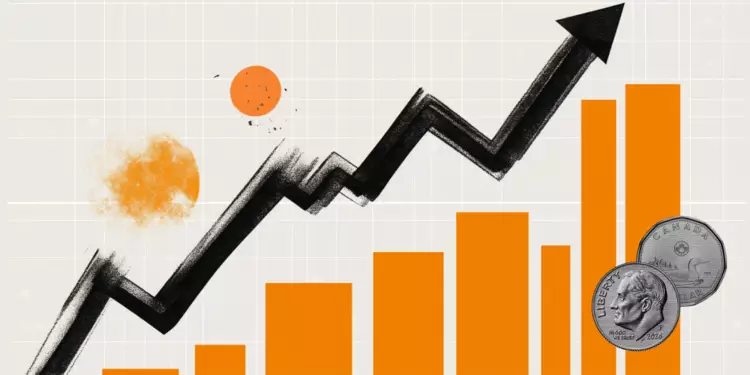In the ever-fluctuating landscape of global currency markets, the USD/CAD pair recently demonstrated a notable rebound, climbing back to approximately 1.4105 during the early hours of the Asian trading session on Thursday. This shift can be attributed to the interplay of several complex factors including U.S. President Donald Trump’s recent announcement regarding tariffs, which has instigated significant changes in market sentiment and trading strategies. The development reflects how sensitive forex pairs can be to geopolitical events and government policies.
Trump’s announcement of a 90-day moratorium on higher reciprocal tariffs is particularly noteworthy. Many traders grasped this as a beacon of potential trade stabilization and an opening for negotiations with U.S. trading partners. This proactive approach from the U.S. administration mitigates immediate fears of a trade war, providing a temporary stability that has positively impacted the USD. The news gives traders a fleeting sense of optimism, allowing the U.S. Dollar to gain some ground against the Canadian Dollar, as evidenced by the movement in the USD/CAD pair.
The Importance of Inflation Data
As the market digests the implications of the tariff announcement, attention will firmly shift to the upcoming Consumer Price Index (CPI) inflation report. This economic data release is pivotal, shaping expectations regarding the Federal Reserve’s monetary policy. Analysts anticipate a year-over-year inflation increase of 2.6%, with the core CPI expected to reflect a rise of 3.0%. This data could serve as a critical determinant for traders as they gauge the likelihood of a Federal Reserve interest rate cut in the near future.
A strong inflation reading could rekindle fears of tighter monetary policy, prompting a reconsideration of previous forecasts and strategies. Ironically, amidst concerns about inflation traditionally being a negative for currency value, the modern dynamic suggests that robust inflation rates can lead to higher interest rates. This reality can paradoxically boost a currency’s appeal as global investors seek refuge in markets offering attractive returns on capital.
The Role of Crude Oil Prices
A significant influencer on the CAD’s performance is the price of crude oil, given Canada’s status as the largest oil exporter to the U.S. Rising oil prices typically bolster the Canadian Dollar as they enhance the country’s trade balance and economic prospects. Any recoveries in crude prices not only inject confidence into the commodity-linked Looney but also have a ripple effect on broader economic indicators in Canada.
The relationship between oil and the CAD is an essential one, deeply rooted in Canada’s export dynamics. When oil prices rise, the demand for the Canadian Dollar tends to increase, benefiting its valuation. Conversely, in times of declining oil prices, traders often respond by selling off CAD, leading to a depreciation of the currency. As global markets exhibit volatility and fluctuations in energy prices become commonplace, it is clear that the fortunes of the CAD are tightly interwoven with the oil market.
Macroeconomic Indicators and Investor Sentiment
Beyond tariff announcements and inflation data, various macroeconomic indicators provide a window into the overall health of the Canadian economy, which influences the CAD’s strength. Key data points, including GDP growth, employment numbers, and purchasing managers’ indices (PMIs), serve as barometers for economic vitality. Strong economic data can fuel confidence in the CAD, fostering investor sentiment that is fundamentally supportive.
Moreover, global investor sentiment plays a pivotal role in currency valuation. Risk-on sentiment tends to favor the CAD, as investors gravitate toward higher-yielding and riskier assets during times of optimism. Conversely, in risk-averse environments where flight to safe-haven currencies becomes the norm, the CAD can weaken significantly. The correlation between broader market sentiment and the currency’s movements underscores the fluid nature of forex trading.
Interest Rates and the Bank of Canada’s Influence
The Bank of Canada (BoC) is a crucial player in regulating the CAD’s strength through its interest rate policies. The BoC aims to maintain inflation within a target range while adjusting interest rates to align with economic conditions. When the bank signals an inclination to raise rates, often in response to inflation or economic growth, it generally leads to an appreciation of the CAD as higher interest rates attract foreign capital.
However, the BoC also possesses tools like quantitative easing which can negatively impact currency strength when employed. These intricacies underscore the need for traders to remain vigilant regarding BoC announcements, as even subtle shifts in monetary policy can have outsized effects on the Canadian Dollar’s trajectory.
The evolving geopolitical landscape and its impact on trade negotiations, combined with the health of both economies and their respective monetary policies, promise to keep USD/CAD traders on their toes. Understanding the interplay of these elements will be crucial for navigating the market successfully in this era of uncertainty.

